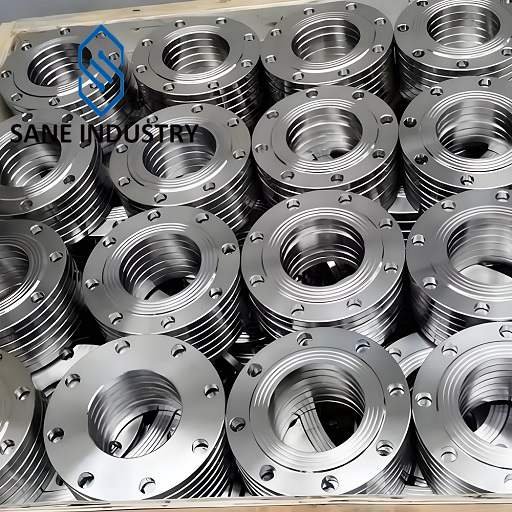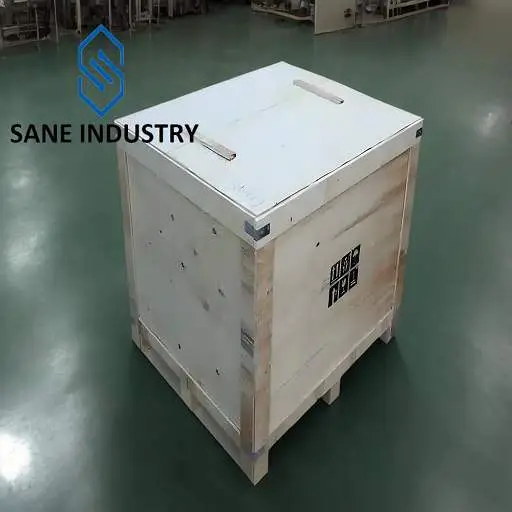What is a Pipe Flange
A pipe flange is a critical mechanical component designed to connect sections of piping systems, valves, pumps, or equipment by forming a secure and leak-proof joint. Typically circular in shape with a raised rim or collar, it features bolt holes or slots to align and fasten mating flanges using bolts or studs. Flanges enable modular assembly, simplify maintenance, and allow integration of accessories like pressure gauges or strainers into pipelines.
Pipe Flange Types
- Welding Neck Flange (WN)
- Structure: Features a long tapered hub that merges smoothly into the pipe wall. Includes a raised face (RF) or flat face (FF) for gasket seating.
- Installation: Welded to the pipe via a butt weld (neck and pipe have matching bevels).
- Applications: High-pressure/high-temperature systems (oil and gas, chemical plants). Ideal for critical systems requiring structural integrity.
- Advantages: Reduces stress concentration, ensures leak-free performance, and handles thermal expansion.
- Drawbacks: Higher material and welding costs.
- Slip-On Flange (SO)
- Structure: A ring with a slightly larger inner diameter than the pipe, allowing it to slide over the pipe.
- Installation: Fillet-welded on the outer side (and sometimes inner side) to secure it to the pipe.
- Applications: Low-pressure systems (water treatment, HVAC), temporary setups, or non-critical pipelines.
- Advantages: Easy alignment, cost-effective, and faster installation.
- Drawbacks: Less robust under bending stress or cyclic loading.
- Threaded Flange (TH)
- Structure: Contains internal threads matching the pipe’s external threads. No welding required.
- Installation: Screwed onto the pipe, often with sealant for leak prevention.
- Applications: Low-pressure systems, non-hazardous fluids (air, water), or locations where welding is unsafe (explosive environments).
- Advantages: Easy assembly/disassembly, ideal for small-diameter pipes.
- Drawbacks: Weak under high vibration or thermal cycling; unsuitable for thick-walled pipes.
- Blind Flange (BL)
- Structure: A solid disk with bolt holes but no center bore, used to seal pipeline ends or pressure vessel openings.
- Installation: Bolted to a mating flange, with a gasket in between.
- Applications: Isolating sections of pipelines, testing pressure integrity, or future expansion points.
- Advantages: Simple design, excellent sealing capability under extreme pressure.
- Drawbacks: Adds weight to the system and cannot transmit flow.
- Lap Joint Flange (LJ)
- Structure: Used with a stub end (a short pipe segment). The flange rotates freely around the stub end.
- Installation: The stub end is welded to the pipe, while the flange slides over it and bolts to a mating flange.
- Applications: Systems requiring frequent disassembly (e.g., cleaning, inspection), or misaligned bolt holes.
- Advantages: Easy alignment adjustment, reusable flanges.
- Drawbacks: Higher initial cost due to the stub end; lower pressure tolerance.
- Socket Weld Flange (SW)
- Structure: Has a socket (recess) to insert the pipe, followed by a single fillet weld on the outer side.
- Installation: Pipe is inserted into the socket and welded.
- Applications: Small-diameter, high-pressure pipelines (hydraulic systems, steam lines).
- Advantages: Stronger than slip-on flanges, smooth flow path.
- Drawbacks: Difficult to inspect internal weld quality; not ideal for corrosive fluids.
- Orifice Flange
- Structure: Includes tapped holes for metering connections and a concentric/eccentric bore for flow measurement.
- Installation: Paired with an orifice plate sandwiched between two flanges.
- Applications: Flow rate measurement in oil, gas, or chemical industries.
- Advantages: Integrates measurement devices without disrupting the pipeline.
- Drawbacks: Complex design, higher cost.
- Long Welding Neck Flange (LWN)
- Structure: Similar to a standard welding neck but with an extended hub. Resembles a nozzle.
- Installation: Butt-welded to the pipe or vessel.
- Applications: Heavy-duty applications like reactor vessels, heat exchangers, or high-stress junctions.
- Advantages: Distributes stress evenly, ideal for severe service conditions.
- Drawbacks: Bulky and expensive.
- Reducing Flange
- Structure: Combines two different pipe sizes in a single flange (e.g., 6-inch to 4-inch bore).
- Installation: Welded or bolted to connect pipes of different diameters.
- Applications: Pipeline diameter transitions without additional fittings.
- Advantages: Space-saving, minimizes welding work.
- Drawbacks: Limited pressure ratings compared to standard flanges.
- Square Flange
- Structure: Square-shaped instead of circular, with bolt holes on each corner.
- Installation: Bolted to compatible equipment or flanges.
- Applications: Low-pressure, non-circular ducts (ventilation systems, lightweight structures).
- Advantages: Fits unconventional pipe shapes.
- Drawbacks: Rarely standardized; limited industrial use.
- By Material
- Carbon Steel Flange
- Stainless Steel Flange
- Alloy Steel Flange
How are Pipe Flanges made
- Material Selection
- Primary Materials: Carbon steel, stainless steel, alloy steel (e.g., A182 F22/F91), cast iron, or duplex steel, chosen based on application requirements (pressure, temperature, corrosion resistance).
- Standards Compliance: Materials adhere to specifications like ASME B16.5, ASTM A105 (carbon steel), or ASTM A182 (stainless steel).
- Forming Methods
- Forging:
- Heated metal billets are shaped under high pressure using hydraulic presses or hammers to align grain structures, enhancing strength and fatigue resistance.
- Common for high-pressure flanges (e.g., welding neck, socket weld).
- Casting:
- Molten metal is poured into molds to create rough flange shapes, suitable for low-cost, non-critical applications (e.g., blind flanges).
- Plate Cutting:
- Flat steel plates are cut into circular blanks via plasma or laser cutting, typically for slip-on or threaded flanges.
- Forging:
- Machining Operations
- Lathe Turning:
- Rough-formed flanges are mounted on CNC lathes to achieve precise outer diameters, bore sizes, and face surfaces (raised, flat, or ring-type joint).
- Drilling Bolt Holes:
- Bolt holes are drilled around the flange’s circumference according to standardized bolt circle diameters (e.g., ANSI 150# or 300#).
- Surface Finish:
- Critical sealing surfaces (e.g., raised face) are machined to a smooth finish (125–250 µin Ra) to ensure proper gasket sealing.
- Lathe Turning:
- Heat Treatment
- Normalizing/Annealing:
- Forgings are heated to specific temperatures and cooled slowly to relieve internal stresses and improve ductility.
- Quenching and Tempering:
- Alloy steel flanges undergo quenching (rapid cooling) and tempering to balance hardness and toughness.
- Normalizing/Annealing:
- Surface Coating & Protection
- Anti-Corrosion Treatments:
- Electroplating (zinc, nickel) or powder coating is applied to prevent rust in corrosive environments.
- Passivation:
- Stainless steel flanges are treated with nitric acid to remove free iron particles and enhance oxide layer formation.
- Anti-Corrosion Treatments:
- Quality Inspection
- Dimensional Checks:
- Verify bolt hole alignment, thickness, and outer diameter against ASME/ANSI standards.
- Non-Destructive Testing (NDT):
- Ultrasonic testing (UT) or radiography detects internal defects like cracks or voids.
- Pressure Testing:
- Flanges are subjected to hydrostatic or pneumatic tests to validate leak-tight performance under rated pressure.
- Dimensional Checks:
- Marking & Certification
- Engraving:
- Each flange is stamped with material grade, size, pressure rating, manufacturer’s logo, and heat code.
- Documentation:
- Mill test reports (MTRs) certify chemical composition, mechanical properties, and compliance with industry standards.
- Engraving:
What is Pipe Flange used for
- Oil & Gas
- Pipeline Networks: Connect segments of pipelines transporting crude oil, natural gas, or refined products.
- Offshore Platforms: Withstand high-pressure, corrosive environments in subsea equipment and risers.
- Refineries: Join valves, pumps, and reactors in processing units.
- Chemical Processing
- Reactors & Vessels: Seal connections in high-temperature/pressure chemical reactors.
- Corrosive Fluid Handling: Use stainless steel/alloy flanges for acid or alkali transport.
- Power Generation
- Steam Systems: Link boilers, turbines, and condensers in thermal power plants.
- Cooling Water Lines: Connect pumps and heat exchangers in nuclear or coal-fired plants.
- Water & Wastewater
- Treatment Plants: Assemble pipes, filters, and pumps in municipal water systems.
- Sewage Systems: Use durable flanges in corrosive, abrasive wastewater environments.
- HVAC & Construction
- HVAC Ducting: Join air handling units, chillers, and ventilation ducts.
- Building Services: Install firefighting pipelines or gas supply lines.
- Pharmaceuticals & Food
- Sanitary Systems: Utilize polished stainless steel flanges for hygienic fluid transfer.
- CIP (Clean-in-Place) Systems: Enable quick disassembly for sterilization.
- Shipbuilding & Marine
- Engine Rooms: Connect fuel lines, cooling systems, and exhaust pipes.
- Ballast Systems: Secure seawater piping with corrosion-resistant flanges.
Our Pipe Flange Dimensions and Material
| Nominal Size | DN15 to DN2000 (1/2″ to 80″ NPS) | |
| Pressure Class | PN20 to PN420 (Class150 to Class2500) | |
| Type | Weld neck, slip-on, socket-weld, lap joint, blind, threaded, long neck welding, orifice, special, etc. | |
| Material Grade | A/SA-105 | |
| A/SA-350 | LF1, LF2, LF3, LF5, LF6, LF9 | |
| A/SA-694 | F42, F46, F48, F50, F52, F56, F60, F65, F70 | |
| A/SA-182 | F1, F2, F5, F9, F91, F11, F12, F21, F22, F304, F309, F310, F316, F317, F321, F347, F44, F45, F51, F53, F55, F60, etc. | |
| B/SB-151 | C70600, C71500, C74500, C75200, C77000, C79200, etc. | |
| B/SB-564 | N010276, N06200, N06022, N02200, N04400, N06600, N08800, N08810, N08825, N10675, N10629, etc. | |
| B/SB-381 | F1, F3, F5, F7, F9, F11, F12, F21, F25, F30, F38, etc. | |
For other customized requirements, please contact us.
What is the Pipe Flange Price
Please contact our sales manager Allen@sanesteel.com
Why Choose Us
- a 16-year pipe flange supplier. We are experts.
- solutions for all your needs
- the highest product quality
- the low lead times
- excellent customer service








